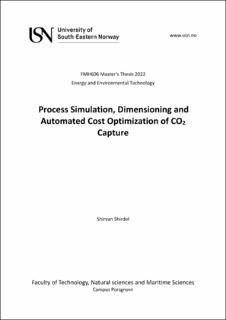Process Simulation, Dimensioning and Automated Cost Optimization of CO2 Capture
Master thesis
Permanent lenke
https://hdl.handle.net/11250/3006846Utgivelsesdato
2022Metadata
Vis full innførselSamlinger
Sammendrag
The use of an amine solvent to remove CO2 from the exhaust gas is an established and well-studied technology. Available emission data from prior research on a natural gas-based power plant project at Mongstad, Norway, was used to model a typical CO2 capture process in Aspen HYSYS. To undertake cost optimization, a Base Case was created with 15 m absorber packing height, 10 m desorber packing height, the removal efficiency of 85 %, and a minimum temperature approach (ΔTmin) in the lean/rich amine heat exchanger of 10 °C. To estimate and quantify the total cost for the basic scenario, the Enhanced Detailed Factor (EDF) was employed in combination with the Aspen In-Plant Cost estimator. The Base Case results showed a total cost of 42.9 EUR per ton of CO2 removed and the reboiler energy use of 3750 kJ/kg.
In the sensitivity analysis, the absorber packing height, the minimum temperature approach (ΔTmin), and the entering flue gas temperature into the absorber column were all altered to find out how different factors affected pricing variations. When the sensitivity analysis changed the size, the Power-Law approach was applied to vary the equipment cost. Using the Adjust and Recycle blocks, as well as switching the calculated values between the simulation and spreadsheets, makes the analysis more automated.
When the ΔTmin was changed from 5 °C to 20 °C, in both automatic and manual scenarios, the variation in predicted cost from 11 °C to 15 °C was minimal.
Since changing the number of stages in an automated assessment is not possible, the stage’s efficiency was changed from 0.15 to 0.9, which is equivalent to increasing the number of steps from 13 to 18. The optimum calculated packing height was 15 m, with a CO2 collection cost of 42.6 EUR/t in the manual analysis. The automated calculated costs were on average 1.5 % and 0.9 % higher than the manual technique when the target stages for changing efficiency were the 13th stage, and the 10th stage, respectively.
A 15-stage absorber was employed to automatically assess the change in incoming flue gas temperature to the absorber from 30 to 50 degrees Celsius in 5 °C steps. The computed captured cost was around 2% lower than the Base Case research due to employing lower amine flow rate by enhancing average stages’ efficiency. Similar research for a simulated case with a 13-stage absorber resulted in a cost reduction of more than 4% compared to the Base Case. When the step size was lowered to 1 °C, the best input temperature was determined to be 34 °C, with an estimated cost of 39.6 EUR per ton of CO2 captured.
The major goal was to use the Aspen HYSYS software to automatically calculate and optimize the cost of an MEA-based CO2 capture facility. This study states automated optimization of absorber packing height and gas inlet temperature using the Case Study tool in Aspen HYSYS, which has not been done before.
